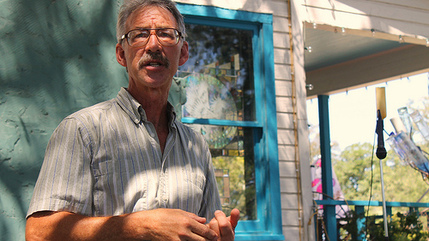
tel: 512 280-1192 Friday, Aug 30 2013
Nursery notes: Labor day weekend sale! Sat, Sun & Mon: 30%
palms / 20% off pottery (excludes talavera) / 20% metal yard art -



trellises, arches, benches, planters, animals. Opening hours: Sat &
Sun 9 a.m - 6 p.m. Monday: 9 a.m. - 4 p.m.

Visionary farmer Tim Miller returns to the nursery next Sunday,
Sept 8 at 2 p.m. for a free lecture. Not to be missed! Creative and
Original Solutions to Gardening Through a Three -Year Drought
Cycle. Learn from Farmer Tim (of the Milberg Farm in Kyle) some
exciting concepts in water conservation for your fall garden: trench
composting, techniques for seeding in arugula with peppers, eggplants
and brassica. Also Tim will share specific planting dates for the fall,
and will talk about multiplying onions.
________________________________________________________
Central Texas Gardener KLRU TV. See how the Sustainable Food
Center is building their new gardens, keeping plants cool in the heat,
and prepping for fall planting. On tour, friendship and food unite at
Sunshine Community Gardens. Sat. noon, 4 p.m. or Sun. at 9 a.m.
www.klru /
______________________________________________________
Thomas Woltz, Wild by Design: a fascinating profile of this unique
landscape architect for whom 'beauty springs from the ecological health
of the land.' “This idea of decorating the outdoors is not what we do,”
he explains. From the pages of Garden & Gun.
_______________________________________________________
The Austin Cactus and Succulent Society's Fall 2013 Show this
Sat. and Sun. 10 a.m. - 5 p.m. Zilker Botanical Gardens. For complete
details, visit http://austincss.com/member/ShowSale.html

The Joy of Collard Greens
by Mick Vann
Collards grow like a weed in these parts in the fall, through the winter,
and well into the spring; when it gets hot they typically bolt and go to
seed, making the leaves bitter.
They descended from wild cabbages that once grew in Europe. They a
re a continuous crop, meaning that you can harvest the outer leaves
while the center continues to grow.
Collards can be seeded, or planted as starts. Most nurseries have several
varieties of starts at the moment, including the ever-popular ‘Vates.’
Collards prefer full to half sun, rich fertile soil high in nitrogen, reg-
ular water, good drainage, and organic mulch. Plant them 1-foot apart,
and expect them to yield for 6 months or so if they are regularly
harvested; increase the mulch when it warms in the spring to insulate
the roots and deter blooming. If you get any insect pests, expect small
beetles or caterpillars.
A pot of collard greens is always referred to in the South as a “mess
of greens”, and the vitamin-rich, bacon-seasoned savory broth in the
bottom of the pot is called potlikker. Traditionally the white plantation
owners of the South consumed the cooked and drained collard greens
while the slave cooks, who understood the high nutrient value of
potlikker, saved the broth to supplement their family’s diets.
Nothing is better for soaking up the potlikker than a hot piece of crusty
cornbread that’s been split down the middle and slathered with sweet
butter. The Potlikker and Cornpone Debate in February and March of
1931 pitted Julian Harris, an editor at the Atlanta Constitution, against
Huey “The Kingfish” Long, the backwoods populist governor and
soon to be U.S. senator-elect from Louisiana.
The traditionalist Harris contended that Southerners must crumble
cornpone into potlikker, criticizing Long as an unrefined rube, who
contended that the cornpone should instead be dunked.
What started as a lighthearted fluff piece in the local paper turned into
a 23-day long news event that captivated the South (and much of the
rest of the nation, once it spread on the wires), and ended up dealing
with all sorts of cultural affairs, including race relations, gender, social
class, elitism, and regional chauvinism. For what it’s worth, we prefer
eating our potlikker-soaked chunk of buttered cornbread with a spoon,
so as not to lose any of that precious elixir.
______________________________________________________
Mick’s Collard Greens
2 bunches collard greens, washed well, central ribs removed, chopped
coarsely
¾ pound thick-sliced bacon, sliced thinly
1 large onion, halved and sliced
6 cloves garlic, minced
2 cups rich chicken stock
3 to 4 tablespoons Balsamic vinegar, to taste
2 to 3 tablespoons white sugar, to taste
1 to 2 teaspoons coarsely ground black pepper, to taste
Cornbread to soak up the potlikker
______________________________________________________
In a large stock pot with a lid, sauté the bacon over medium low heat
until the fat is rendered and the bacon golden brown. Add the onion
and sauté over medium heat until transparent, about 5 minutes. Add
the garlic and sauté 30 seconds. Add the collards and stir well, briefly
sautéing the greens in the bacon fat. Add the chicken stock, stir well,
and place the lid on the pot. Allow the greens to cook down for about
20 minutes, stirring occasionally, and add 3 tablespoons of the vinegar,
2 tablespoons of the sugar, and 1 teaspoon of the black pepper. Stir
well for a minute and taste for seasonings. The broth should be rich
from the bacon and stock, there should be underlying saltiness from
the bacon, and the vinegar and sugar should add a subtle sweet-tart
flavor. Cook for another 5 minutes and taste again, adding more vinegar,
sugar, and pepper if desired. Do a final tasting for salt just before service.
Serve in a bowl with plenty of the pottliker. A piece of crusty hot
buttered cornbread makes an excellent accompaniment.
______________________________________________________
Mick Vann: cookbook author, food writer, chef, restaurant consultant,
horticulturist. Read Mick's excellent blog:http://gustidude.blogspot.com/
off
 Visit the website: www.itsaboutthyme.com
Visit the website: www.itsaboutthyme.com Visit the nursery:11726 Manchaca Road, Austin, 78748